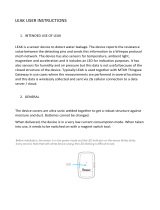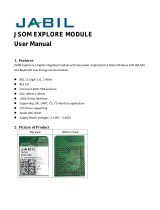OTODATA C020 BLE-ES3016 Guide d'installation
- Taper
- Guide d'installation

Installaon Procedure
C020 BLE—ES3016

ES3016
Telemetry I2C interface with
BT transceiver for mulple
sensor and control
capabilies
INPUT
I2C bus with Bulk M12 for Hall eect, Thermal or level sensors
REPORTING & OUTPUTS
Measured parameter (5% variaon)
Low baery
High/Excessive variaon
Temperature
Data Interface Raw data
Client mobile app
Automated Tesng Connecon status
Baery status
ELECTRICAL SPECIFICATIONS
Baery Pack Hybrid LTC 8.5Ah ~ 3.6 Vdc
RADIO SPECIFICATIONS
Receiver Freq. : 2402.000MHz ~ 2480.000MHz
Modulaon : GFSK
Transmier Freq. : 2402.000MHz ~ 2480.000MHz
Modulaon : GFSK
Output: 4.73dBm
FEATURES
• Auto-Pairing to any Otodata ready sensor
• Android and IOS apps
• Ready to install
ENVIRONMENTAL SPECIFICATIONS
Operang & storage -40C to +85C -40F to 185F
temp. range
Relave humidity range 0% to 100%
Enclosure rang IP67
Warranty 1 year
CERTIFICATIONS
ISED RSS-247, Issue 2 IC Registraon: 12649A-BEHT3AD
FCC Part 15 Subpart C FCC ID: 2ADQFBEHT3AD
DIMENSIONS
Height 41mm[1.6in], Width 130mm[5.1in], Depth 66mm [2.6in]
ORDERING OPTIONS
ES3016-DH - Digital Hall sensor
ES3016-DT - Digital Temperature sensor
ES3016-DL - Digital Lidar sensor
This device complies with part 15 of the FCC Rules. Changes or modicaons not expressly approved by the party responsible for compliance could void the user's authority to operate the equipment operaon is
subject to the following two condions: (1) This device may not cause harmful interference, and (2) this device must accept any interference received, including interference that may cause undesired operaon.
This device is compliant with Industry Canada's RSS standards for licence-exempt radio apparatuses. Authorized use depends on the following two condions: (1) the device must not create radio interference,
and (2) the device user must accept all radio interference, even if this interference could potenally impair its funconing. This equipment has been tested and found to comply with the limits for a Class B digital
device, pursuant to part 15 of the FCC Rules. These limits are designed to provide reasonable protecon against harmful interference in a residenal installaon. This equipment generates, uses and can radiate
radio frequency energy and, if not installed and used in accordance with the instrucons, may cause harmful interference to radio communicaons. However, there is no guarantee that interference will not occur
in a parcular installaon. If this equipment does cause harmful interference to radio or television recepon, which can be determined by turning the equipment o and on, the user is encouraged to try to
correct the interference by one or more of the following measures: --Reorient or relocate the receiving antenna. --Increase the separaon between the equipment and receiver. --Connect the equipment into an
outlet on a circuit dierent from that to which the receiver is connected. --Consult the dealer or an experienced radio/TV technician for help.

M/N: ES3016
F/W: 1.0
IC: 12649A-BEHT3AD
FCC ID: 2ADQFBEHT3AD FAIT AU
CANADA
Barcode
ISED non-interference disclaimer
This device contains licence-exempt transmier(s)/receiver(s) that comply with
Innovaon, Science and Economic Development Canada’s licence-exempt RSS(s).
Operaon is subject to the following two condions:
1. This device may not cause interference
2. This device must accept any interference, including interference that may cause
undesired operaon of the device.
L’émeeur/récepteur exempt de licence contenu dans le présent appareil est
conforme aux CNR d’Innovaon, Sciences et Développement économique Canada
applicables aux appareils radio exempts de licence. L’exploitaon est autorisée
aux deux condions suivantes :
1. L’appareil ne doit pas produire de brouillage;
2. L’appareil doit accepter tout brouillage radioélectrique subi, même si le
brouillage est suscepble d’en compromere le fonconnement.
RF Exposure statement for ISED
This equipment complies with ISED RSS-102 radiaon exposure limits set forth for
an uncontrolled environment. This equipment should be installed and operated
with minimum distance 20 cm (7.6 inches) between the radiator and any part of
your body. This transmier must not be co-located or operang in conjuncon
with any other antenna or transmier.
Our se conformer aux exigences de conformité ISED RSS-102 RF exposion, une
distance de séparaon d'au moins 20 cm doit être maintenue entre l'antenne de
cet appareil et toutes les personnes. Lanceurs ou ne peuvent pas
coexister cee antenne ou capteurs avec d'autres.
RF Exposure statement for FCC
This equipment complies with FCC radiaon exposure limits set forth for an
uncontrolled environment. This transmier must not be co-located or operang in
conjuncon with any other antenna or transmier. In order to avoid the
possibility of exceeding the FCC radio frequency exposure limits, this equipment
should be installed and operated with minimum distance 20 cm (7.8 inches)
between the antenna and your body during normal operaon. Users must follow
the specic operang instrucons for sasfying RF exposure compliance.
Label on Device:

Installaon of the device
3. Proceed to the Bluetooth pairing by downloading the Otodata TechApp, available for Android or IOS.
3.1 Start the app on your phone
Sensor Connector
1. Unpack your device and ensure all parts look good with no damage.
2. If the sensor was shipped disconnected from the box, you can connect it now. Look for the correct posion of
the connector by aligning the half moon marks.

3.5 Once the process is
nished you will be able
to use your device in the
regular Nee-Vo app.
BLE Pairing
3.3 Conrm
This process will link your
Otodata ES3016 to this
Smartphone.
3.4 Select your device
from the displayed list
3.2 Select BLE Pairing
My Tank
-
 1
1
-
 2
2
-
 3
3
-
 4
4
-
 5
5
OTODATA C020 BLE-ES3016 Guide d'installation
- Taper
- Guide d'installation
dans d''autres langues
Autres documents
-
Scosche BTFM3B Manuel utilisateur
-
 Haltian TSLEAK Manuel utilisateur
Haltian TSLEAK Manuel utilisateur
-
 JABIL JSOM-XP Explore Module Manuel utilisateur
JABIL JSOM-XP Explore Module Manuel utilisateur
-
Sonoff SNZB-06P Manuel utilisateur
-
OKIN BT-CB.02 Manuel utilisateur
-
ET2 E35101 iCorona 24 Inch LED Flush Mount Mode d'emploi
-
Sonoff MINIR4M Manuel utilisateur
-
Sony GTK-XB72 Guide de référence
-
Victrola VPB-400 Portable Bluetooth Speaker Manuel utilisateur
-
Pentax K-3 Mark III Le manuel du propriétaire






